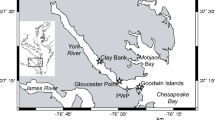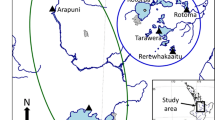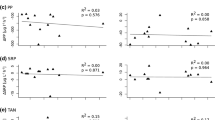Abstract
Arsenic uptake from water and from phytoplankton was followed in the copepod Eurytemora affinis and the barnacle Balanus improvisus collected from the Patuxent River estuary, Chesapeake Bay, eastern coast of the USA in 1987, and in the oyster Crassostrea virginica obtained from a hatchery on the shore of Chesapeake Bay in 1987. Dissolved arsenic was readily taken up by phytoplankton and by shell material of B. improvisus and C. virginica; however, no dissolved arsenic was incorporated into the invertebrate tissues. When E. affinis, B. improvisus and C. virginica were fed phytoplankton containing elevated arsenic contents, significant arsenic incorporation occurred. Juvenile B. improvisus incorporated relatively more arsenic than adults of all three species. Compared to the 100 to 200% increase in arsenic content by phytoplankton exposed to dissolved arsenic, the 25 to 50% increase in these invertebrate species via trophic transfer is relatively small. Even though the trophic pathway for arsenic transfer is the major one for higher trophic levels within an ecosystem, the potential for direct arsenic impact to trophic levels other than phytoplankton appears to be minimal.
Similar content being viewed by others
Literature cited
Blanck, H., Holmgren, K., Landner, L., Norin, H., Notini, M., Rosemarin, A., Sundelin, B. (1987). Advanced hazard assessment of arsenic in the Swedish environment. In: Landner, L. (ed.) Approaches to advanced hazard assessment of chemicals in the aquatic environment. Final report from the ESTHER program to the Research Council, National Swedish Environmental Protection Board, Stockholm, p. XI-1–XI-75
Blanck, H., Wangberg, S.-A. (1988a). The validity of an ecotoxicological test system. Short-term and long-term effects of arsenate on marine periphyton communities in laboratory systems. Can. J. Fish. aquat. Sciences 45: 1807–1815
Blanck, H., Wangberg, S.-A. (1988b). Induced community tolerance in marine periphyton established under arsenate stress. Can. J. Fish. aquat. Sciences 45: 1816–1819
Blum, J. J. (1966). Phosphate uptake by phosphate-starved Euglena. J. gen. Physiol. 49: 1125–1136
Boyle, E. A., Huestedt, S. (1983) Aspects of the surface distributions of copper, nickel, cadmium, and lead in the North Atlantic and North Pacific. In: Wong, C. S., Boyle, E., Bruland, K. W., Burton, J. D., Goldberg, E. D. (eds.) Trace metals in sea water. Plenum Press, New York, p. 379–394
Braman, R. S., Johnson, D. L., Foreback, C. C., Ammons, J. M., Bricker, J. L. (1977). Separation and determination of nanogram amounts of inorganic arsenic and methylarsenic compounds. Analyt. Chem. 49: 621–625
Crecelius, E. A. (1977). Changes in the chemical speciation of arsenic following ingestion by man. Envir. Hlth Perspectives 19: 147–150
DaCosta, E. W. B. (1972). Variation in the toxicity of arsenic compounds to microorganisms and the suppression of the inhibitory effects by phosphate. Appl. Microbiol. 23: 46–53
D'Elia, C. F., Sanders, J. G., Boynton, W. R. (1986). Nutrient enrichment studies in a coastal plain estuary: phytoplankton growth in large-scale, continuous cultures. Can. J. Fish. aquat. Sciences 43: 397–406
Edmonds, J. S., Francesconi, K. A. (1981). Arseno-sugars from brown kelp (Ecklonia radiata) as intermediates in cycling of arsenic in a marine ecosystem. Nature, Lond. 289: 602–604
Edmonds, J. S. Francesconi, K. A. (1987). Trimethylarsine oxide in estuary catfish (Cnidoglanis macrocephalus) and shool whiting (Sillago bassensis) after oral administration of sodium arsenate; and as a natural component of estuary catfish. Sci. total Envir. 64: 317–323
GESAMP (Group of Experts on the Scientific Aspects of Marine Pollution) (1986). Working group on review of potentially harmful substances. Hazard evaluation for arsenic. World Health Organization, Geneva
Guillard, R. R. L., Ryther, J. H. (1962). Studies on planktonic diatoms. I. Cyclotella nana Hustedt and Detonula confervacea (Cleve) Gran. Can. J. Microbiol. 8: 229–239
Hanaoka, K., Matsumoto, T., Tagawa, S., Kaise, T. (1987). Microbial degradation of arsenobetaine, the major water soluble organoarsenic compound occurring in marine animals. Chemosphere (U.K.) 16: 2545–2550
Kaise, T., Watanabe, S., Itoh, K. (1985). The acute toxicity of arsenobetaine. Chemosphere (U.K.) 14: 1327–1332
Klumpp, D. W. (1980). Accumulation of arsenic from water and food by Littorina littoralis and Nucella lapillus. Mar. Biol. 58: 265–274
Lindsay, D. M., Sanders, J. G. (1989). Arsenic uptake and transfer in a simplified estuarine food chain. Envir. Toxic. Chem. (in press)
Lunde, G. (1973). The synthesis of fat and water soluble arseno organic compounds in marine and limnetic algae. Acta chem. scand. 27: 1586–1594
Lunde, G. (1977). Occurrence and transformation of arsenic in the marine environment. Envir. Hlth Perspectives 19: 47–52
Macek, K. S., Pettrocelli, S. R., Sleight, B. H. (1979). Considerations in assessing the potential for, and significance of, biomagnification of chemical residues in aquatic food chains. Aquat. Toxic. (A.S.T.M.) STP 667: 251–268
Norin, H., Sandstrom, M. Christakopoulos, A. (1987). Organo arsenic compounds following administration of inorganic arsenic in aquatic ecosystems. Presented at the Nordic seminar on evaluation of test systems in the aquatic environment, Sweden, October 1987 (Unpublished paper)
Notini, M., Rosemarin, A. (1986) Fate and effects of arsenic in a mososcale model ecosystem. Status report prepared for the ESTHER Project, Swedish Environmental Research Group, Karlskrona. Sweden, January (Unpublished paper)
Planas, D., Healey, F. P. (1978). Effects of arsenate on growth and phosphorus metabolism of phytoplankton. J. Phycol. 14: 337–341
Rosemarin, A., Notini, M., Holmgren, K. (1985). The fate of arsenic in the Baltic Sea Fucus vesiculosus ecosystem. Ambio 14: 342–345
Sanders, J. G. (1985). Arsenic geochemistry in Chesapeake Bay: dependence upon anthropogenic inputs and phytoplankton species composition Mar. Chem. 17: 329–340
Sanders, J. G. (1986). Direct and indirect effects of arsenic on the survival and fecundity of estuarine zooplankton. Can. J. Fish. aquat. Sciences 43: 694–699
Sanders, J. G., Cibik, S. J. (1985). Adaptive behavior of euryhaline phytoplankton communities to arsenic stress. Mar. Ecol. Prog. Ser. 22: 199–205
Sanders, J. G., Cibik, S. J. (1988). Response of Chesapeake Bay phytoplankton communities to low levels of toxic substances. Mar. Pollut. Bull. 19: 439–444
Sanders, J. G., Osman, R. W., Brownlee, D. C. (1988). Arsenic transport and impact in Chesapeake Bay food webs. U.S. Environmental Protection Agency CBP/TRS 18/88. (Copies available from: Chesapeake Bay Liaison Office, 410 Severn Ave., Annapolis, Maryland 21403, USA)
Sanders, J. G., Riedel, G. F. (1987a). Chemical and physical processes influencing bioavailability of toxics in estuaries. In: Lynch, M. P., Krome, E. C. (eds) Perspectives on the Chesapeake Bay: advances in estuarine sciences. Chesapeake Research Consortium, P.Q. Box 1120, Gloucester Point, VA 23062, USA, p. 87–106 (Chesapeake Research Consortium Publication No. 127)
Sanders, J. G., Riedel, G. F. (1987b). Control of trace element toxicity by phytoplankton. Recent Adv. Phytochem. 21: 131–149
Sanders, J. G., Ryther, J. H., Batchelder, J. H. (1981). Effects of copper, chlorine, and thermal addition on the species composition of marine phytoplankton. J. exp. mar. Biol. Ecol. 49: 81–102
Sanders, J. G., Vermersch, P. S. (1982). Response of marine phytoplankton to low levels of arsenate. J. Plankton Res. 4: 881–893
Sanders, J. G., Windom, H. L. (1980). The uptake and reduction of arsenic species by marine algae. Estuar. cstl mar. Sci. 10: 555–567
Spacie, A., Hamelink, J. L. (1985). Bioaccumulation. In: Rand, G. M., Pettrocelli, S. R. (eds.) Fundamentals of aquatic toxicology. Hemisphere Publishers, Washington, D.C., p. 495–525
Uthe, J. F., Freeman, H. C., Johnston, J. R., Michalik, P. (1974). Comparison of wet ashing and dry ashing for the determination of arsenic in marine organisms, using methylated arsenicals for standards. J. Ass. off. analyt. Chem. 57: 1363–1365
Valiela, I. (1984) Marine ecological processes. Springer-Verlag, New York
Wrench, J. J., Addison, R. F. (1981). Reduction, methylation, and incorporation of arsenic into lipids by the marine phytoplankton Dunaliella tertiolecta. Can. J. Fish. aquat. Sciences 38: 518–523
Zaroogian, G. E., Hoffman, G. L. (1982) Arsenic uptake and loss in the American oyster, Crassostrea virginica. Envir. Monitg Assessmt 1: 345–358
Author information
Authors and Affiliations
Additional information
Communicated by J. M. Lawrence, Tampa
Rights and permissions
About this article
Cite this article
Sanders, J.G., Osman, R.W. & Riedel, G.F. Pathways of arsenic uptake and incorporation in estuarine phytoplankton and the filter-feeding invertebrates Eurytemora affinis, Balanus improvisus and Crassostrea virginica . Mar. Biol. 103, 319–325 (1989). https://doi.org/10.1007/BF00397265
Accepted:
Issue Date:
DOI: https://doi.org/10.1007/BF00397265




